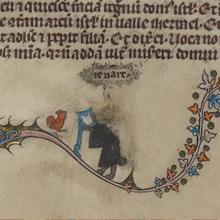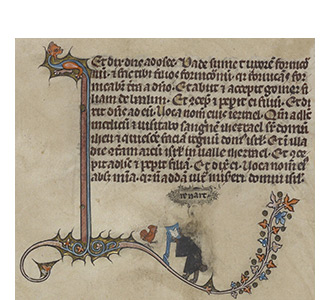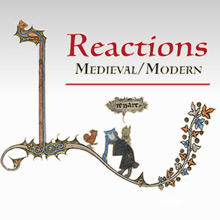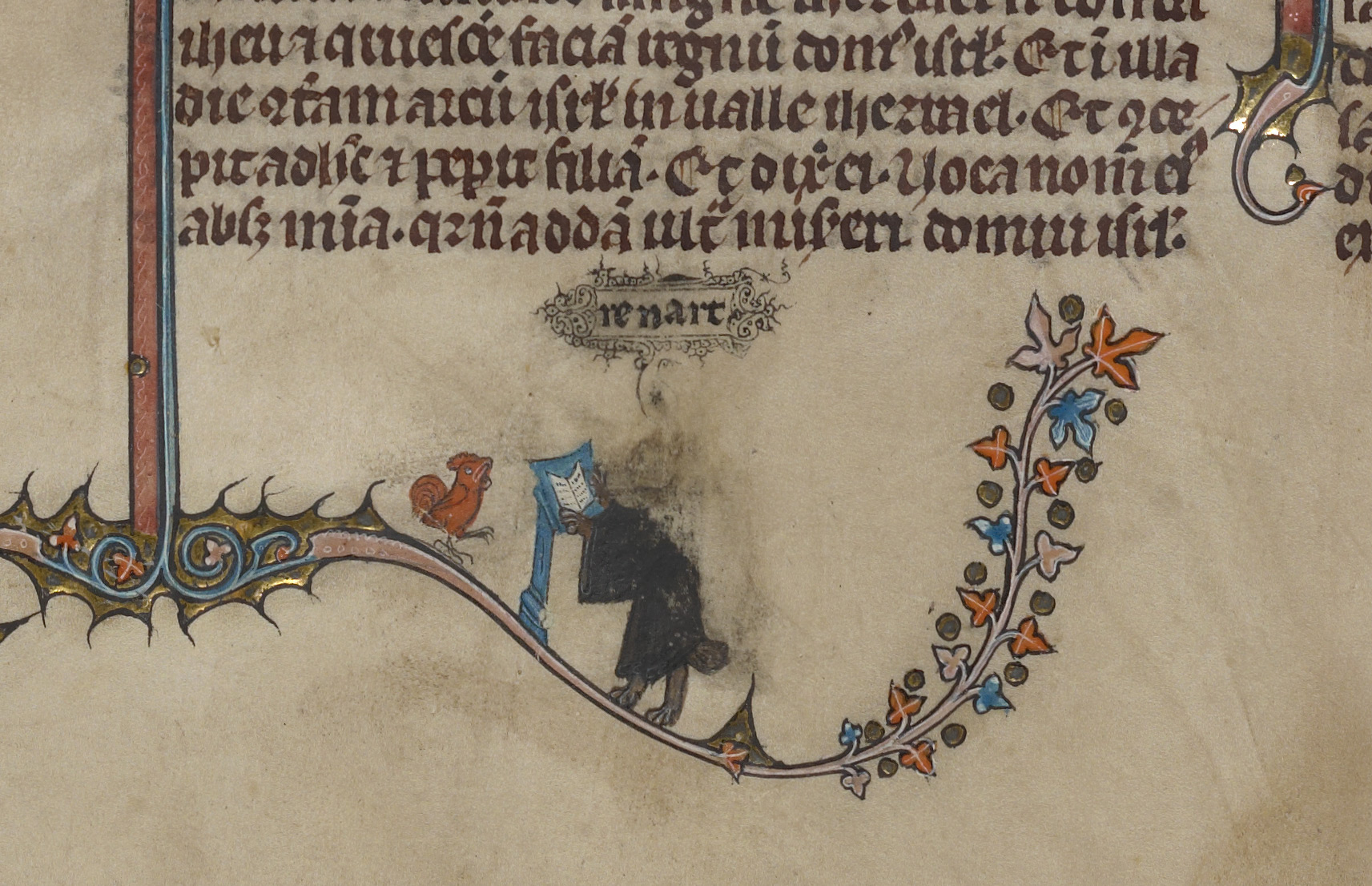In partnership with the Rare Book Department of the Free Library of Philadelphia, the Schoenberg Institute for Manuscript Studies (SIMS) at the University of Pennsylvania is pleased to announce the 9th Annual Lawrence J. Schoenberg Symposium on Manuscript Studies in the Digital Age.This year's theme, "Reactions: Medieval/Modern," gives us space to explore the many and varied ways that people have reacted to, and acted upon, manuscripts from the Middle Ages up to today. Reactions take many forms. They include the manipulation of physical objects through, for example, the marking up of texts, addition of illustrations, the disbinding of books or rebinding of fragments, as well as the manipulation of digital objects, thanks to new technologies involved in digitization, ink and parchment analysis, virtual reconstruction, among many other processes. This symposium will also tackle how popular culture has reacted to manuscripts over time as witnessed by their use and appearance in books, games, and films.
The program begins Thursday evening at 5:00 pm on November 17 at at the Free Library of Philadelphia, Parkway Central Library, with a reception followed with the keynote address at 6:00 pm by Michelle P. Brown, Professor emerita of Medieval Manuscript Studies at the School of Advanced Study, University of London, and former Curator of Manuscripts at the British Library. The symposium continues, November 18-19, at the Kislak Center of Special Collections, Rare Books, and Manuscripts at the University of Pennsylvania Libraries, with papers and workshops that delve into various aspects of fragmentation and reconstitution.
Speakers include:
- Angela Bennett, University of Nevada, Reno
- Ray Clemens, Yale University
- Doug Emery, University of Pennsylvania Libraries
- William Endres, University of Oklahoma
- Pat Fish, LuckyFish.com, Santa Barbara, CA
- Fenella France, Library of Congress
- Alexandra Gillespie, University of Toronto
- Bryan Haberberger, Saint Louis University
- Dorothy Kim, Vassar College
- Bruce Holsinger, University of Virginia
- Erik Kwakkel, Leiden University
- Yael Rice, Amherst College
- Marina Rustow, Princeton University
- Marianna Shreve Simpson, Independent Scholar
- Beeke Stegman, University of Copenhagen
- Jon Sudbury, Jon Sudbury Games
- Drew Thomas, University of St. Andrews
- Jeffrey Witt, Loyola University of Maryland
Join the symposium Facebook group to connect with other attendees or tweet @SIMS_Mss #msreactions to start a discussion.
The symposium is made possible with the generous support of the Arnamagnæan Institute at the University of Copenhagen and the Dean's Office of the University of Pennsylvania's School of Arts and Sciences.

What does digitization and the digital humanities mean for medieval manuscripts? What is the scholarly reaction to the digital mediation of medieval manuscripts? What does this mean for the history of the book and editing? This talk will take up these questions and ask, in particular, how does a digital reaction to medieval manuscripts shift the terrain and praxis of manuscript editing? In particular, I would like to use the model of "thick mapping" discussed in Todd Presner, Yoh Kawano, and David Shepard's Hypercities volume and companion website (Harvard, 2014). In their book, they discuss "thick mapping" as methods that are "design-centered, critical interrogations and interpretations of the multiplicity, heterogeneity, and ambiguity of the cultural record of places..." it is "about exploring, participating, and listening, something that transforms our conception of mapping into a practice of ethics. At the core of this book is an idea about the possibility of expanding participation and the value of knowledge in the service of the public good" (p.6). This talk will consider the possibilities of "thick archiving" in reconceptualizing the medieval manuscript matrix. How does archive theory, feminist materialism, and postcolonial criticism help shape a thick medieval manuscript archive?
While social media are great tools to communicate academic knowledge to a broad audience of non-experts, using such media for this purpose comes with particular challenges. To reach a large audience, jargon and nuance, and sometimes even substance are pushed to the background in favor of entertainment. Moreover, academics are limited in their choice of topics: vivid and exceptional cases seem better suited than regular--more representative--topics. This paper gauges how manuscripts are presented in social media. What compromises do scholars make when bringing manuscripts to the masses? What is the balance between flash and substance? The paper ultimately questions if it is possible to share expert knowledge of medieval manuscripts with an online audience of non-experts.
The transfer of Persian and Indian deluxe manuscripts from their original site of production to other cultural contexts, both within and beyond the Islamic world, often has been accompanied by textual and material modifications. These include features that today are relatively easy to spot and to identify: marginal annotations, repainted or inserted paintings, ownership seals and inscriptions, and replacement bindings. By contrast, picture tabs have largely escaped attention in Islamic manuscript studies, although they occur in a variety of distinctive forms, colors and sizes. Far from being inconsequential, these place markers, together with other modifications and insertions, can help document a manuscript's peregrinations and contribute to our understanding of its audience and audience reaction.
Tattoo artist Pat Fish has worked for over 30 years translating the intricate knotworks of illuminated manuscripts into art in skin. She will present images showing how the designs once worked on vellum can now live again in the skin of contemporary enthusiasts who wish to celebrate a connection to the past.
Presenting a very personal case study, in the creation and publishing experience of the card game Ortus Regni. I created this game while a history student and started the project with a clean slate. I sought to replicate not only a medieval theme for the game, but also started with the question "how would gamers in the late 14th century have gone about this endeavor?" Thus the game is a Renaissance Faire style recreation experience of what a "card battler" (i.e. akin to Magic the Gathering, as opposed to Bridge) might have been, in that period, and also is itself the result of another form of reenactment. A primary result of this process was the very early realization that the cards would be wholly pictorial. Literacy, of course, being a very limited skill set in its era. This choice had several knock-on effects. And, as one can imagine, the resulting game is and has been very polarizing in the modern gaming industry. Which is a commercial entertainment industry that operates, understandably, under quite different rules than those which produced Ortus Regni.
This paper will take up the subject of so-called uterine vellum, those tissue-thin membranes allegedly derived from the skins of unborn or abortive animals. In the modern world--in novels, poetry, and the popular imagination--uterine vellum has prompted diverse emotional responses: disgust, repulsion, fascination, and so on. With reference to codicological and biomolecular approaches, the paper will explore the wildly varying approaches to evidence, emotion, and argument offered within distinctive creative and disciplinary idioms grappling with this enduringly fascinating material.
At last year’s Schoenberg symposium, I described both automated and artisanal ways of finding joins among the vast remains from the Cairo Geniza. The techniques are applicable to other caches. This presentation goes deeper into one of those methods: tracking how scribes recycled writing supports, on the sides of both supply and demand.
Scholars of the early twentieth century presented the history of the Mughal illustrated manuscript as one of stable development. Each manuscript, according to this model, marked incremental progress towards an imminent artistic and bibliographical end. More recent studies, in contrast, have emphasized the mutability of the illustrated Mughal manuscript, and thus shown its history to be more contingent than predetermined. From the very inception of the manuscript tradition in the mid-16th century, codex, text, and image were treated as potentially changeable elements: illustrations were liberally over-painted, manuscripts re-margined, and written surfaces edited and re-copied. These cases have nevertheless been interpreted as regrettable exceptions to a rule: the enduring, immutable manuscript still takes precedence. This paper argues that mutability was a fundamental, rather than incidental, aspect of manuscript production, use, and reception. Mughal manuscripts, in other words, were expected to be altered and reconstituted to suit their owners' particular needs. This validation of the mutable Mughal manuscript, however, challenges the very idea that codices want to remain whole; it is on this point in particular that this paper will dwell.
The Beinecke Rare Book and Manuscript Library recently acquired what remains of the archive of Otto F. Ege, famed bookbreaker and manuscript dealer. While the broken leaves have importance, the library’s real interest in the collection was to acquire and make available for study the nearly 70 codices that had not been seen since his death in 1951 and to promote scholarship that would contribute to an understanding the workings of Ege’s operation. This talk will detail what we have discovered to date about Ege’s method of breaking and selling manuscripts from looking at the remnants of his acquisitions. We will also survey some of the 70 manuscripts and fragments that came with the collection. While most of these don’t currently have historical value, they do show Ege’s intentions, I believe, in building a teaching collection that would show on a grand scale the same types of manuscripts featured in his famous leaf books.
The Icelandic professor and collector Árni Magnússon (1663-1730) assembled one of the most important collections of Scandinavian manuscripts. Apart from saving many of the manuscripts from destruction, he physically altered hundreds of codices. This paper investigates the nature of these changes and discusses the underlying rationale. Árni Magnússon had a specialized collection with a focus on Icelandic and Scandinavian history and literature. As printing was still not very common in Iceland in the seventeenth and early eighteenth centuries, manuscripts were actively produced during this time, and handwritten sources were essential for scholarly work. Árni's collection had the character of a research library that aimed at both preserving the unique material and making it easily accessible for scholarship. The latter meant that he freely dismembered and re-arranged the manuscripts in his collection in order to facilitate research. Árni's collection can be characterized as a flexible and open library. On the one hand, he constantly added to it by acquiring new material, and on the other, he continually adjusted the individual manuscripts according to his needs. The paper manuscripts in his collection thereby underwent particularly intense custodial treatment. Árni made this constant change part of his design of the collection and systematically prepared the manuscripts for continuous re-arrangement. Upon arrival, he separated larger codices into small units of usually one text each, which could then be moved and (re-)combined in various ways. Having such a flexible and interactive library allowed Árni to physically bring together the different materials for his changing projects.
This workshop will focus on attempts to unite the datasets of various research groups with interests relating to the scholastic intellectual tradition. Some of these groups are focused on manuscript identification and description. Others are focused on transcriptions and the construction of digital editions. Still others are focused the construction of prosopographies and bibliographies. At the same time, thanks to the ongoing success of International Image Interoperability Framework (IIIF) increasing number of libraries are exposing images of manuscripts essential to the study of the scholastic tradition. In this presentation, I will focus on the attempt of the Scholastic Commentaries and Texts Archive (SCTA) -- a database of RDF metadata -- to unite these related but currently fragmented resources. The goal of this unification is not only to make possible the discovery of new connections, but also to enable the construction of display applications that can make use of the entire web of connected data rather than the isolated data collected by a single research group. During this workshop, I will highlight a few different client applications (such as the IIIF viewer Mirador and a digital edition viewer called LombardPress) that can exploit the connections exposed in the SCTA database. Using this united dataset, viewers like these can offer users a single research interface built from images, texts, and supplemental data scattered across the web.
This paper presents "corpus studies" as a new methodology for thinking about the materiality of medieval literary culture in manuscripts. Aggregate Reading is a response to the radical ethical call for a more inclusive mode of understanding literary history through the totality of its material culture rather than through canonical or neo-canonical text and object selection. I argue for the urgency and importance of a new mode for anti-canonical reading, and then I demonstrate how it might work in a case study of the Piers Plowman corpus.
What is the manuscript without the parchment and ink? The physicality of the original manuscript is often overlooked in the intense scholarly focus on the text, yet no one who has handled a rare or historic volume ever forgets the texture, weight and feel of the manuscript, opening the cover, turning the leaves. Bearing the burden of longevity, the essence of the manuscript resides in the expertise of the vellum preparer and the composition of the ink and colorants. These materials also shed light on the location, trade routes and wealth of the creators, with expensive pigments sometimes being extended with less costly ones. The combinations of trace elements in the ink can either be durable, or cause deterioration of the parchment, the very words eating through the leaves. Why does one manuscript survive while others perish? The interaction between ink and substrate is complex, and new technologies can reveal traces of history that are not evident to the unaided eye. Excavating this information to create new layers of data, brings new perspectives on original manuscripts, the digital layers of data peeling back and exposing new content.
Advances in digital photography present scholars and conservators with tempting choices when digitizing manuscripts. Techniques such as multispectral, hyperspectral and x-ray florescence imaging capture worn and damaged text no longer visible to the unaided eye. Other techniques capture further aspects of materiality, such as Reflectance Transformation Imaging (RTI), which provides a hyper-view of surface details. However, these innovations encourage past photographs and their visual information to be overlooked. Even worse, limited space in libraries has encouraged past images to be discarded, especially when new advanced imaging technologies promise to record richer visual information. In this talk, I will discuss results from my efforts to digitize and compare 125 years of photographs of the eighth-century St Chad Gospels. These images include photographic methods that would appear to provide limited, if any, value -- such as a copy from a 1920s Photostat machine (the precursor to the photocopier). But whether Photostat copy or 19th-century print, once digitized and registered (even loosely in Photoshop or ImageJ), historical images can be overlaid and compared, revealing irreplaceable knowledge about aging, knowledge that otherwise is beyond knowing.
In video games, as in much medieval literature, an old book is often a portal to or within another world. Players of games such as The Elder Scrolls V: Skyrim can spend hours puzzling over in-game manuscripts: fans can download add-ons that let them rebind the books they encounter in the game, and then build their own manuscript libraries. So what can video games and gaming bring to the study of medieval manuscripts? And how can medieval manuscript scholarship enrich the art and experience of interactive games?
The workshop will begin with some answers to those questions that have emerged from the Book of Fame, a game conceptualization and prototyping project from the Old Books New Science Lab at the University of Toronto. The Book of Fame team is using emerging specifications for image sharing to pull digital images of real medieval manuscripts into a game environment. The game then reimagines two-dimensional images as three-dimensional books, and sets them in artists’ dream-like refigurations of some famous libraries. Players are drawn into a narrative that involves both Margaret Atwood and Chaucer (the one who doth tweet), a lost Canterbury tale, some malicious hackers, and the often puzzling experience of textual criticism, codicological analysis, and archive curation.
The workshop will proceed into an open discussion. What is the potential - and what are the pitfalls - of gamification for libraries, archives, and scholars seeking to open medieval books to wider public view? What do games and game players have to teach experts about manuscripts? Can new technologies, including Augmented Reality and Virtual Reality, change the way in which new readers, including undergraduate students, encounter the medieval past?

In conjunction with the 9th Annual Schoenberg Symposium of the same theme, Reactions: Medieval/Modern explores the many and varied ways that people have reacted to, and acted upon, manuscripts from the Middle Ages up to today. Reactions take many forms. They include the manipulation of physical objects through, for example, the marking up of texts, addition of illustrations, the disbinding books or rebinding fragments, as well as the manipulation of digital objects, thanks to new technologies involved in digitization, ink and parchment analysis, virtual reconstruction, among many other processes. Both the exhibition and symposium will also tackle how popular culture has reacted to manuscripts over time as witnessed by their use and appearance in books, games, and films. This exhibition has been archived online and is viewable here.
A soft-cover, 108 page, full-color illustrated companion volume exploring the themes of the exhibition is available for purchase here. It includes an introduction by Dot Porter, exhibition curator, essays by Bruce Holsinger, Erik Kwakkel, Kathryn M. Rudy, Michael Livingston, Angela Bennett, and an exhibition checklist.

Opening Reception and Keynote Address
Thursday, November 17, 2016
Michelle Brown
Professor emerita of Medieval Manuscript Studies at the School of Advanced Study, University of London
with introduction by Will Noel, University of Pennsylvania
From King Athelstan to Game of Thrones: Responses to the Early Manuscript Culture of Britain and Ireland across the Ages
Rare Book Department
Free Library of Philadelphia, Parkway Central Library, 3rd floor
1901 Vine St, Philadelphia, PA, 19103 (map).
Symposium
Class of 1978 Orrery Pavilion
Kislak Center for Special Collections, Rare Books, and Manuscripts
University of Pennsylvania Libraries, Van Pelt-Dietrich Library Center, 6th floor
3420 Walnut St, Philadelphia, PA, 19104 (map).
Friday, November 16, 2018
8:30 - 9:00 am Coffee and Registration
9:00 - 9:15 am Welcome and Opening Remarks
Dot Porter, Schoenberg Institute for Manuscript Studies (SIMS), University of Pennsylvania Libraries
10:00 - 11:15 am Session I
Moderator: Dot Porter, SIMS
Dorothy Kim, Vassar College
Erik Kwakkel, Leiden University
Marianna Shreve Simpson, Independent Scholar
11:00 - 11:30 am Coffee
11:30 am - 12:30 pm Panel Discussion: Medieval Manuscript Digital Projects: The Programmer's Perspective
Moderator: Lynn Ransom, SIMS
12:30 - 2:00 pm Lunch
2:00 - 4:00 pm Session II
Moderator: David J. Wallace, University of Pennsylvania
Pat Fish, LuckyFish.com
Jon Sudbury, Jon Sudbury Games
Bruce Holsinger, University of Virginia
4:00 - 4:30 pm Break
3:45 - 5:00 pm Workshop I
Marina Rustow, Princeton University
Saturday, November 19, 2016
8:30 - 9:00 am Coffee
9:00 - 11:00 am Session III
Moderator: Nicholas Herman, SIMS
Yael Rice, Amherst College
Ray Clemens, Yale University
Beeke Stegmann, Copenhagen University
11:00 - 11:30 am Coffee
11:30 - 12:30 pm Workshop II
Jeffrey Witt, Loyola University of Maryland
12:30 - 2:00 pm Lunch
2:00 - 4:00 pm Session IV
Moderator: Sarah Reidell, University of Pennsylvania Libraries
Angela Bennett, University of Nevada Reno
William Endres, University of Oklahoma
Fenella France, Library of Congress
4:00 - 4:30 pm Coffee
4:30 - 5:30 pm Workshop III
Alexandra Gillespie, University of Toronto
Brainstorming a Game: Medieval Manuscripts
5:30 - 7:00 pm Closing Dinner Reception.
During the reception and throughout the symposium, the exhibit Reactions: Medieval/Modern will be open for viewing in the Goldstein Family Gallery.
